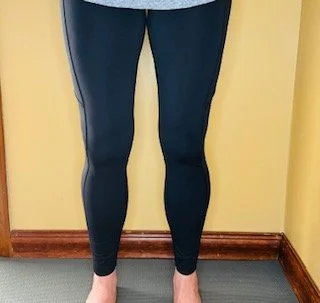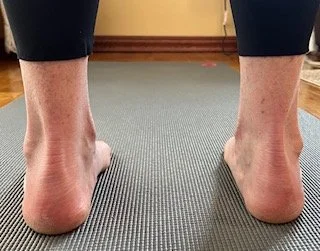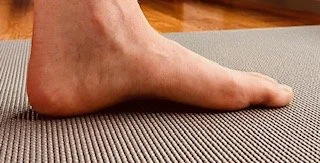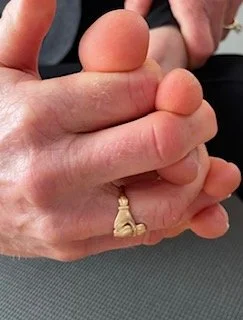Lower Body’s Posture & Alignment- Now That You Know
Continue to increase your knowledge and take control of your lower body’s posture and alignment. This article offers comprehensive explanations aimed at increasing awareness, along with targeted corrective activities and clear exercise instructions designed to support proactive improvement for hips, knees, ankles, feet, and toe functions.
Leg and Foot Alignment
Understanding and Improving Posture And Alignment Through Awareness and Habit Change
Individuals with a history of injuries, surgical procedures, or congenital joint abnormalities in the hips, knees, or ankles may often experience alignment challenges. Although such issues may not be entirely resolvable, wear and tear can often be mitigated and movement efficiency improved by becoming aware of poor movement habits.
When certain muscles become weak or tight, the body compensates by recruiting other muscles to help you stay upright and mobile. For example, prolonged sitting can tighten the muscles at the front of the hips, causing the lower back to work harder during walking to maintain an upright posture. Similarly, if your ankle or hip turns inward, your knee might twist outward with each step to keep your stride straight. Over time, these compensations can lead to pain or further imbalances in other parts of the body.
Increase Awareness
The first step in addressing imbalances is becoming aware of your posture and how you position yourself throughout the day. Simple adjustments can make a significant difference:
Stand up and walk regularly to avoid prolonged sitting.
Uncross your legs when you notice they are crossed.
Observe your hips – If one hip is higher or your pelvis tilts forward or back, adjust to a neutral position.
Visualize your pelvis as a bowl of water - aim to keep it level to avoid “spilling” water forward, backward or to the sides.
Avoid locking (hyperextending) your knees when standing; keep a slight bend or “soften the knees” to reduce stress on the knee joints.
Watch your foot position - if your feet turn inward or outward when walking, try to align them straighter to support healthy leg mechanics.
Every time you adjust your posture and alignment; you help reduce unnecessary stress on your joints. Frequently moving throughout the day also improves circulation: motion is lotion.
Small Adjustments During Rest and Sleep can Make a Big Difference
Maintaining natural hip and spine alignment while you sleep can reduce strain and prevent discomfort from developing overnight.
If you usually sleep on your side, try starting the night on your back.
When side sleeping, place a pillow between your knees to help keep your pelvis aligned.
If the width of your waist is significantly smaller than your hips, placing a small pillow between your waist and the mattress can prevent your spine from bending downward, reducing pressure on your back.
If your legs naturally roll outward when lying on your back, this may indicate tightness in the outer hip muscles. Realign your legs so your knees and toes are pointing upwards.
Be Patient and Consistent
Changing habits takes time, but even small improvements help reduce joint strain and allow your body to recover. Given the right conditions, the body has a remarkable ability to regain balance and function.
Try These Exercises to Improve Mobility
The exercises below are a great starting point to improve range of motion and flexibility in the hips and ankles. This reduces the need for compensatory movements in the knees and lower back. Each stretch should feel good, like a gentle release of tension, never painful. If you experience pain, ease off, as this may indicate you are pushing too hard.
If a specific area is noticeably tight, it may be helpful to hold the stretch for a longer duration or repeat the stretch several times. It is not necessary to perform every stretch listed; three exercises at a time are recommended to support consistency. Concentrate on the areas where tightness is most apparent.
Hip Mobility:
Hip pendulums – To stretch and alleviate pressure in the hip capsule - stand on a step with one leg hanging off, gentle move that leg side to side, then back and forth and in a circular motion, clockwise, then counterclockwise several times each direction.
Leg rolls – To stretch outer thigh and hip muscles – sit or lie on your back with your legs straight, gently rotate your legs inward bringing your big toes together, hold for a few seconds, repeat 10 times.
Butterfly stretch – To stretch inner thigh and groin muscles - sit on the floor with the soles of your feet touching and knees bent outward, hold onto your feet and keeping your back straight, gently lean your chest forward while pressing your knees towards the ground. Hold for a few seconds and repeat 10 times.
Figure-4 – To stretch glute and outer thigh muscles - Sit in a chair and cross one leg placing the ankle on the opposite knee. Keeping back straight, gently lean forward. Hold for a few seconds and repeat with the other leg.
Hip flexors stretch (lunge stretch) – To stretch hip flexors and upper thigh muscles - place right leg on step or stool, left leg stays straight with foot planted on floor, bend right knee and lean forward towards step. Hold stretch for up to 30 seconds. Repeat with left leg.
Hip windshield wipers (Seated) – To stretch external & internal hip muscles - Sit with back supported in a chair or stool so your feet do not touch the floor. Gently swing your right lower leg to the right then left 20 times. Repeat with left leg.
Hip windshield wipers (Prone) - To stretch upper thigh and hip flexors, external & internal hip muscles – lie on stomach, bend right knee with bottom of foot facing the ceiling, keeping thigh touching floor, gently swing right lower leg to the right then left 20 times. Repeat with left leg.
Child Pose (Balasana) – To stretch low back, posterior hip, glutes, and shin muscles – kneel and place chest and stomach on thighs bringing buttocks to heels with forehead resting on floor. Place arms either alongside of body or overhead. Hold pose for several deep breaths, relaxing further into the stretch with each exhale.
Ankle Mobility:
Toe Alphabet - Use your toes to "write" the alphabet in the air.
Ankle circles - Rotate your ankle clockwise and then counterclockwise, making slow and controlled circles.
Toe Raises & Heel Raises - Either in a seated or standing position, alternate lifting your toes then heels off the ground.
Calf muscles stretch - Stand facing a wall with right foot placed several inches behind the left foot. Keep right heel touching the floor while leaning your body and bending your right knee forward until you feel a stretch in your right calf and posterior ankle. Hold up to 30 seconds. Repeat with left leg.
Shin muscles stretch – While in a seated or standing position, bend one leg behind so that the top of your foot touches the floor. Gently press your toes into the floor to feel a stretch across the top of your foot and shin. Hold this position for a few seconds, then repeat with the other foot.
Foot Posture & Toe Alignment
Improving your foot and toe alignments start with becoming more mindful of your footwear:
Try to limit the time spent in high heels or shoes that squeeze your feet.
Choose footwear with a wider toe box that allows your toes to rest naturally.
Go barefoot or wear socks whenever possible, to allow your feet to move more freely.
Gradually ease into walking barefoot as it may feel uncomfortable at first. With time, your feet should adapt and become more tolerant.
To reduce the impact on your feet and legs:
Consider wearing rubber-soled shoes, especially if you tend to walk heavily or carry extra weight.
Be mindful of your walking force. If your footsteps are often heard, especially on upper floors, you may be striking the ground too hard.
If you have flat feet or notice your arches collapsing when you stand or walk:
Using arch support can help. Inserts will prevent your feet from rolling inward, reducing strain on your knees, hips, and lower back.
Strengthening the muscles in your feet may help restore your natural arch and make barefoot walking more comfortable.
Monitor your arch by observing your footprints in the sand or on wet pavement.
Try These Exercises to Improve Foot and Toe Alignment:
Toe mobility: Regularly wiggle, bend, and spread your toes to maintain flexibility.
Toe separation: When washing your feet, gently slide your fingers between your toes to encourage natural spacing.
When resting, utilize toe separators or insert a piece of firm, comfortable material between your toes to assist in realignment.
Toe scrunches: Strengthen the muscles in your feet and toes by placing your feet on a towel and then use your toes to gather up the towel. Focus on lifting your arches as well. I aim for 10 scrunches every morning when stepping out of my shower onto a towel.
Towel or marble pickup: While keeping your heel on the floor, use your toes to pick up a small towel or objects like marbles.
Barefoot walking: Walk barefoot when you can, especially on sand to strengthen the muscles in the feet and calves.
This list of corrective exercises is not exhaustive and should not replace those prescribed by your Health Care Professional. Please consult your Health Care Provider or a Physical Therapist for more individualized exercises and treatments tailored to your specific needs.
You can also review my article on improving Upper Body’s Posture & Alignment. This resource provides deeper narratives aimed at increasing awareness along with specific corrective activities and clear exercise instructions designed to support proactive improvement of forward head and round shoulder postures, thoracic kyphosis and poor shoulder and arm alignment.
Try my second set of assessments on Mobility and Flexibility to check how well your body moves and bends.



